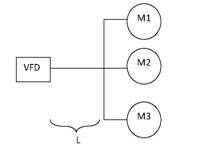Cable length and characteristics are often important factors in ensuring a high quality, dependable drive installation. Certain applications simply require a long motor lead length; moving the motors and/or drives closer to one another may be too costly or space constraints may prevent it. There are the normal cable capacitance, high-frequency pulse, and voltage drop issues, of course, but what if additional motors are added to the mix? Let’s look at one reader’s question:
Q: I intend to connect 6 fans each 1.5 kW to a single VFD unit. The largest distance between the VFD unit and a fan is 25m. However, the total length of cables connected to the 6 fans is about 120m. Is the distance from the drive unit to the most remote fan the significant parameter or is it the total length of cables that is connected to the unit?
 A: The most important consideration in the case of multiple motors connected to a single drive is the length of the leads between the VFD and the point of common connection of the motors. Pictorially, it would look like this, ‘L’ being the dimension of greatest concern:
A: The most important consideration in the case of multiple motors connected to a single drive is the length of the leads between the VFD and the point of common connection of the motors. Pictorially, it would look like this, ‘L’ being the dimension of greatest concern:
The ‘L’ dimension should be kept as short as practicable, because a longer ‘L’ value will effectively decouple the motors from the drive and lead to higher voltage overshoot at each of the motors. That said, even if the ‘L’ distance is maintained practically short most drive manufacturers will warn that total motor lead length must be considered. This is the most conservative approach, as impedances of cables and motors, as well as installation particulars, vary widely between applications. Full analysis would consider drive, cable, and motor characteristics; switching frequency used; critical cable length for standing wave generation; and several other factors; and is sufficiently complex that significant knowledge and experience is required. In our experience, the risk of problems rises with total lead length, and the cost of defining and correcting a problem, even if discovered quickly, can rapidly exceed the capital cost of drive output filtering.
If you’d like additional information or assistance, please contact us at info@joliettech.com, drop by our web site (joliettech.com), or visit the Comments section to drop off some thoughts/questions. And check back soon for another installment.
As always, thanks for reading –

Regards,
Jay Baima
Joliet Technologies


Leave A Comment
You must be logged in to post a comment.